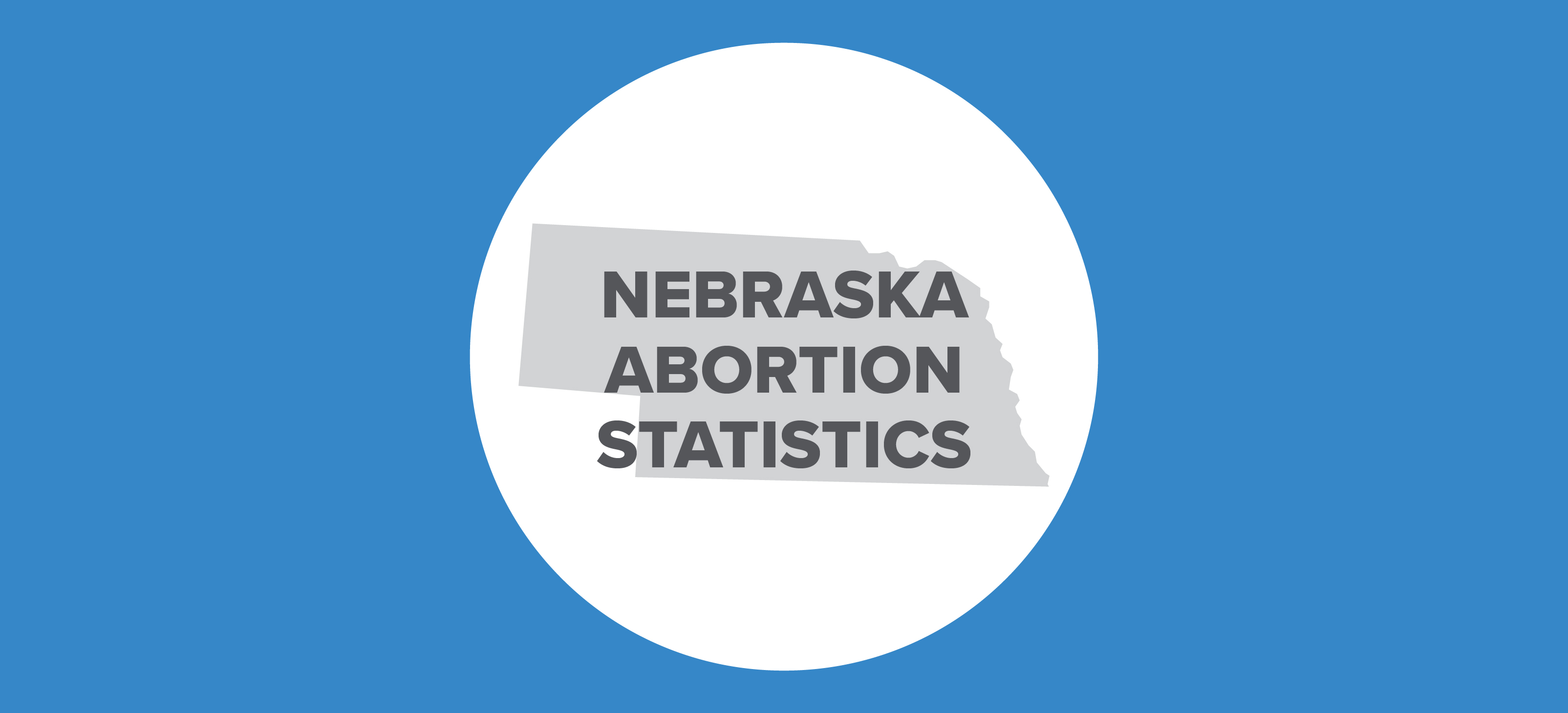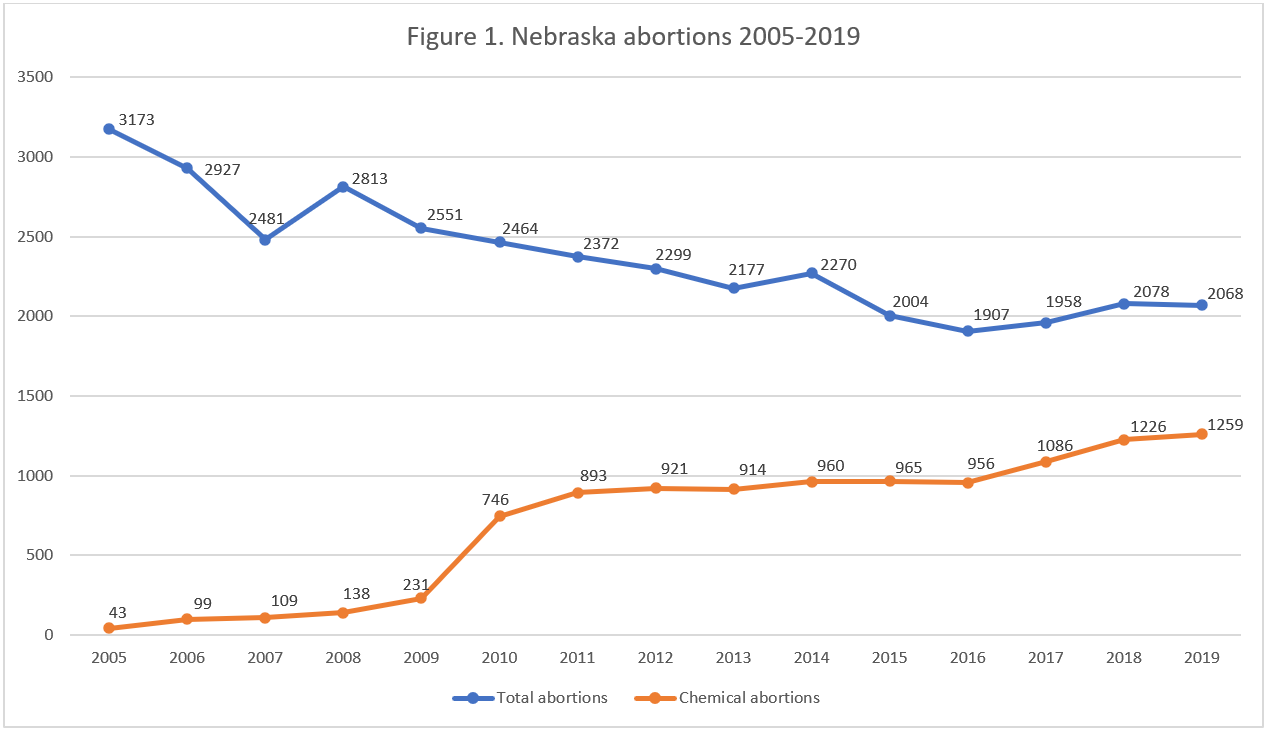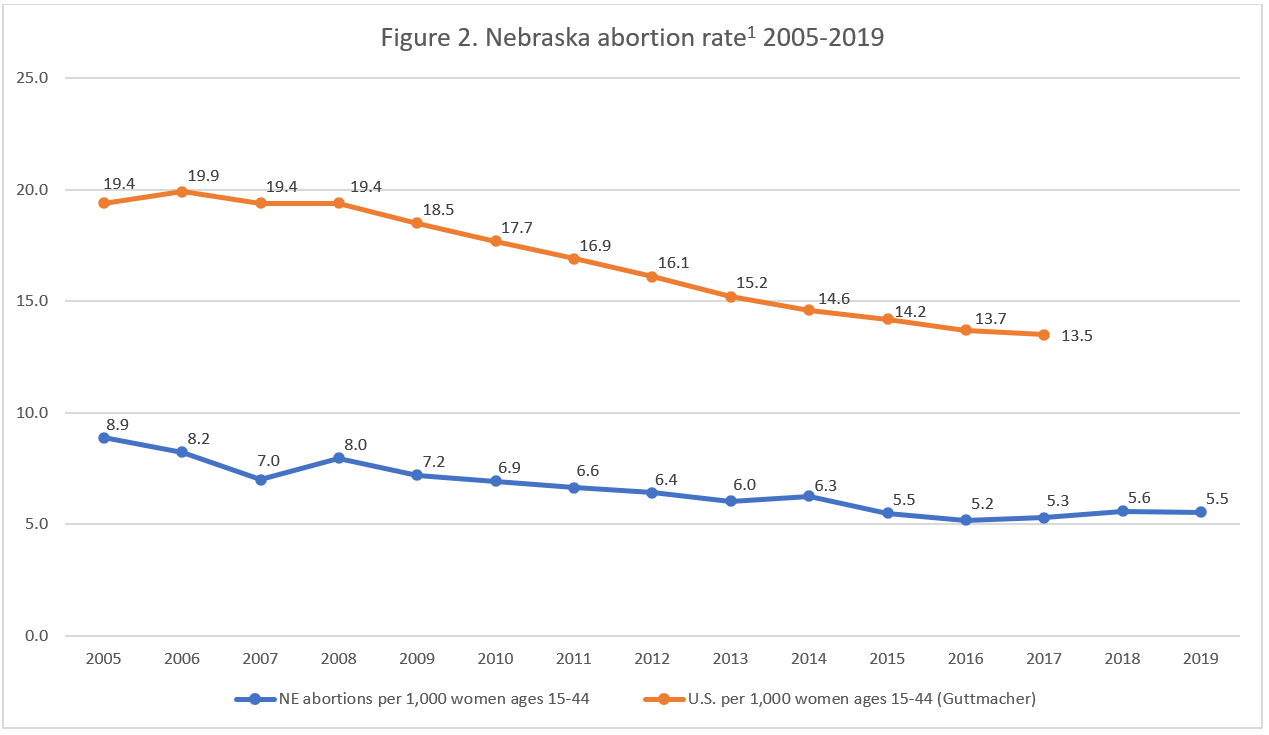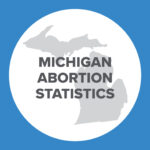Abortion Reporting: Nebraska (2019)

Nebraska’s 2019 abortion report was published in June 2020 by the Nebraska Department of Health and Human Services. The report shows that chemical abortions increased from 2018.
Changes in Nebraska Abortions, 2018-2019

The report does not include information on Planned Parenthood’s Nebraska abortion market share.
Abortion Totals and Trends
There were 2,068 abortions reported in Nebraska in 2019, down slightly from the 2,078 reported the previous year (Fig. 1). Chemical abortions increased by three percent from 1,226 in 2018 to 1,259 in 2019. In 2019, chemical abortions made up 61 percent of all abortions reported in Nebraska. The Charlotte Lozier Institute (CLI) estimates that Nebraska’s state abortion rate was 5.5 abortions per 1,000 women ages 15 to 44, a decrease of one percent from the previous year (Fig. 2). Historically, Nebraska’s abortion rate has been much lower than the national rate.
State Report Summary
Eighty-seven percent of the abortions reported in Nebraska in 2019 were performed on Nebraska residents, and 13 percent were on women from other states. Of the abortions performed on nonresident women, the majority (203 abortions) were on women from Iowa. Nine percent of the abortions were on girls under the age of 20, including three percent on girls under the age of 18. Thirty percent of Nebraska abortions were on women ages 20 to 24, and 26 percent were on women ages 25 to 29. Thirty-one percent of the abortions were performed on women in their thirties, and four percent were on women age 40 or older.
Nebraska’s abortion reporting form allows multiple races to be selected, so the number of abortions of each race sums to more than the total. In 2019, 65 percent of the abortions were on white women. Nineteen percent were on black women, five percent were on Asian women, and two percent were on Native American women. Seven percent of the abortions were performed on women of other races, and four percent were on women whose race was not reported.
The majority of Nebraska abortions, 82 percent, were performed on unmarried women, while 17 percent were on married women and one percent were on women of unknown marital status. Many of the abortions were performed on women who had attended college: 33 percent were performed on women who had completed some college but had no degree, and 16 percent were on women with college degrees. Thirty-seven percent were on women who reported high school as their highest level of education, and 10 percent were on women who had not finished high school. Education was not reported for four percent of the women.
Most of the women undergoing abortions in Nebraska had already experienced a live birth. Twenty-two percent had one previous live birth, and 39 percent had two or more, compared to 40 percent with no previous live births. In contrast, 69 percent of the abortions were on women who had never had an abortion before. Twenty-one percent were on women with one prior abortion and 10 percent on women with more than one. Overall, 31 percent of the abortions were performed on women with no previous pregnancies, 17 percent on women with one prior pregnancy, and 52 percent on women with two or more previous pregnancies.
Nebraska asks women to share their reasons for undergoing abortions. Multiple reasons can be provided for each abortion. As in previous years, the most frequently cited reason, shared by 43 percent of the women, was that no contraception had been used. Seventeen percent of the women said that their contraception had failed. Six percent of the women chose abortion due to socio-economic concerns, and four percent for their mental health. Three percent of the abortions were cited as due to the mother’s physical health. Twenty-two abortions were performed because of a risk to the mother’s life, although the report does not indicate what health concerns necessitated these abortions. Fifteen abortions were performed because the baby had an anomaly. Seven abortions were performed because of rape and one because of incest. Thirty-two percent of the women declined to give their reasons for choosing abortion.
Nebraska’s informed consent process was followed for every abortion except for one, which was performed due to a medical emergency. In Nebraska, parental consent is required before a minor may undergo an abortion. In 2019, 66 girls under the age of 18 obtained abortions in Nebraska. According to Nebraska’s report, parental consent was obtained in 65 cases and not obtained in nine cases. Additionally, exceptions to the parental consent requirement were made in four cases. The report does not indicate why consent or an exception to the consent requirement was obtained for more minors than underwent abortions, but it is possible that some girls did not go on to get abortions.
Nearly half the abortions reported in Nebraska, 47 percent, occurred at six weeks of gestation or earlier, including a third of the total performed between five and six weeks. Almost a quarter were performed between seven and eight weeks of gestation, and 14 percent were performed between nine and 10 weeks. Six percent were performed from 11 to 12 weeks and another six percent from 13 to 15 weeks. Three percent occurred from 16 to 19 weeks of gestation. Just one abortion was reported at 20 weeks, and none were reported after 20 weeks. One abortion was performed at an unknown gestational age. Nebraska limits abortion at 20 weeks post-fertilization, around 22 weeks of gestation, but no abortions were reported this late in pregnancy in 2019.
Twenty percent of the unborn babies killed by abortion weighed less than 100 grams, and four percent weighed 100 grams or more, including three that weighed 400 grams or more. However, 75 percent of the unborn babies were not measurable. Fifty-five percent of the babies were less than 40 millimeters long, while seven percent were 40 millimeters or more. The length of 38 percent of the babies could not be measured.
Six doctors reported abortions in Nebraska in 2019. Four doctors performed just a few abortions each, together performing 27 abortions. Another doctor performed 700 abortions, and the final doctor performed 1,341 abortions. Forty percent of the abortions occurred in Douglas County, 34 percent in Sarpy County, and 26 percent in Lancaster County. Two abortion complications were reported in 2019: one case of hemorrhaging and one uterine perforation.1
Chemical abortions made up the majority of Nebraska abortions in 2019, composing 61 percent of the total. Thirty-six percent were performed using suction curettage, and three percent were dilation and extraction procedures. There were six dilation and evacuation abortions, one sharp curettage procedure, and one other, unidentified abortion procedure.
Second-Trimester Abortion Procedures
Second-trimester abortion procedures reported in Nebraska demonstrated a shift between 2018 and 2019. A relatively large number of dilation and extraction (D&X) abortions occur in Nebraska, possibly due to the presence of an abortion center operated by Leroy Carhart, an abortion doctor who twice went to the Supreme Court to argue for the use of the procedure in partial-birth abortion (Stenberg v. Carhart in 2000 and Gonzalez v. Carhart in 2007). There were 54 D&X abortions reported in 2019, essentially unchanged from 2018, when 53 D&X abortions occurred in Nebraska. However, abortions performed using the very similar procedure dilation and evacuation (D&E) dropped from 32 in 2018 to just six in 2019. Despite the decline in D&E procedures, second trimester abortions held steady, with 124 abortions at 14 weeks of gestation or later reported in 2019, very close to the 122 abortions reported in 2018. The report does not state which abortion procedure was used in lieu of dilation and evacuation, but it is possible that some of these were second-trimester chemical abortions.
On August 17, 2020, the Governor of Nebraska signed into law a bill to limit dilation and evacuation abortions. The bill applies restrictions to D&E abortions similar to the restrictions on dilation and extraction abortions, which cannot be performed on a live unborn baby. An abortion provider would have to induce the unborn baby’s death before beginning a D&E procedure instead of dismembering a living unborn baby.
State Recommendations
Nebraska could improve its reporting and provide relevant information by cross tabulating its data, particularly abortions by gestation and type of procedure. Additionally, Nebraska could provide more details on its informed consent and parental consent processes. The Cornhusker State could include the number of girls who did or did not go on to obtain abortions after their parents provided consent and could also state whether any of the girls were emancipated minors. Finally, in light of the low reported number of complications despite the increasing number of chemical abortions, which have been found to result in higher rates of hemorrhage and incomplete abortion, the state could actively survey its emergency rooms and urgent care clinics to identify increases in these adverse events.


- Statistics on abortion complications reported here represent a minimal number of deaths and complications, as this data is collected in a non-systematic and non-verifiable way. As such, this data cannot be used to calculate either an accurate abortion mortality rate or an accurate abortion complication rate for the state.
- Rates were calculated by CLI using population estimates from the United States Census Bureau. The rates were calculated using the following formula: (total number of abortions performed in Nebraska ÷ number of resident women ages 15-44) x 1,000. Rates may differ slightly from previous CLI articles due to revised population estimates.
Click here to view reporting from:20242023202220212020201820172016


























